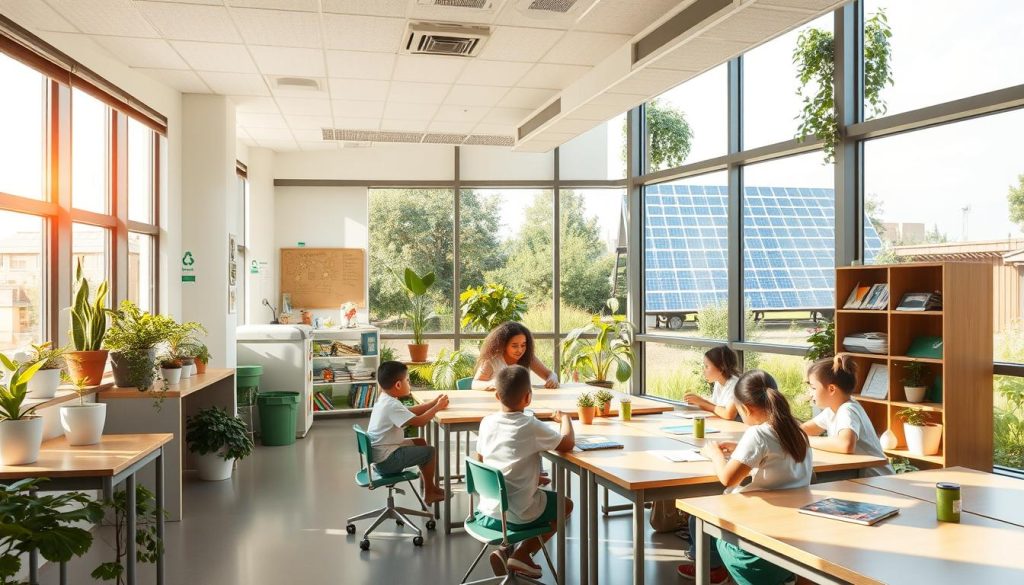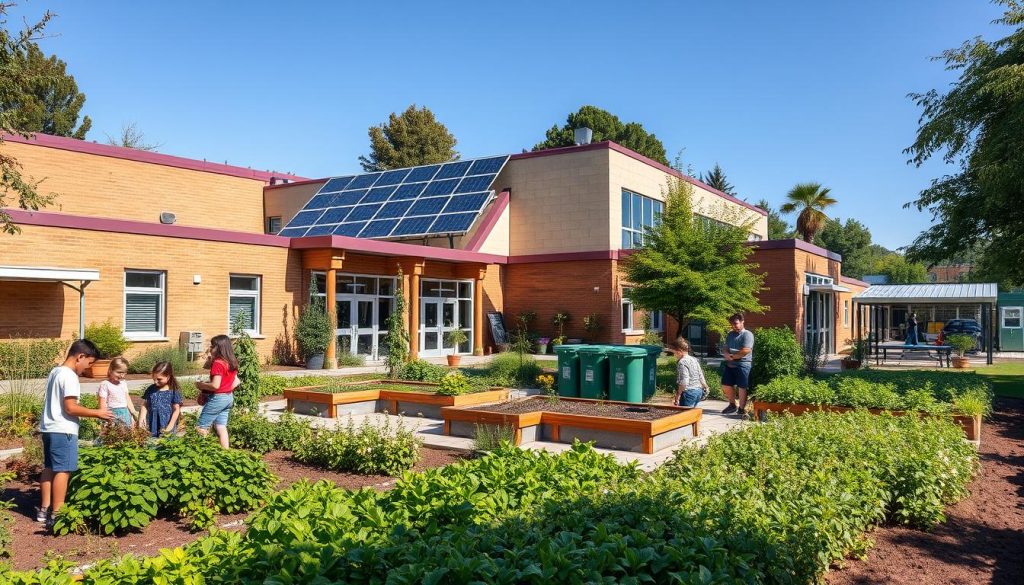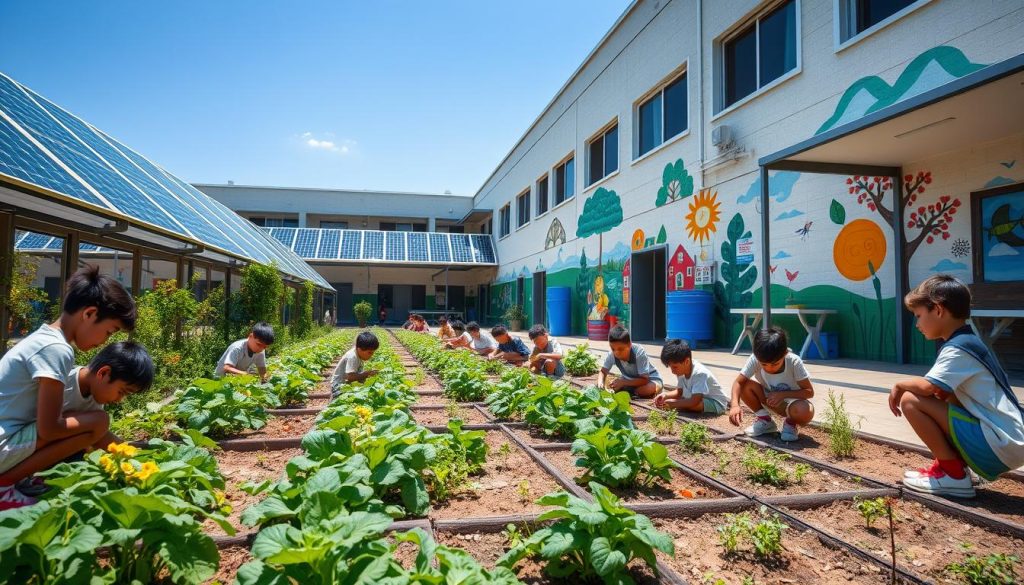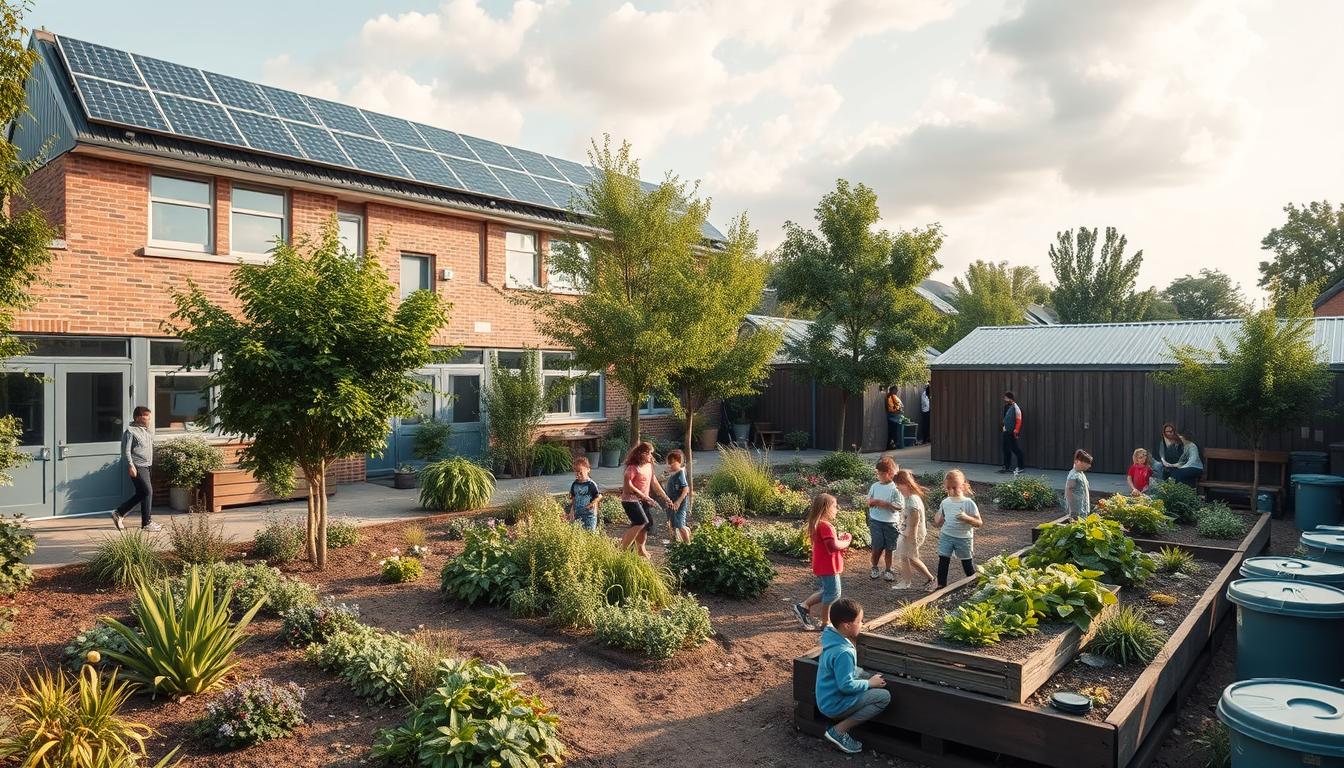I’ve seen a big change in schools across the United States. More schools are starting sustainable programs. These efforts are changing how we learn and our effect on the planet.
Environmental education is now a big part of school lessons. It’s not just about recycling. It’s about teaching kids to think differently about the world.
These programs include things like saving energy and growing gardens. They’re making a big impact. They’re helping to raise a generation that cares about the environment. I think this move towards sustainability in schools is very important for our future.
Understanding the Importance of Sustainable School Programs
I think sustainable school programs are key for our future. They introduce eco-friendly practices into learning, helping students and communities. Let’s see why they’re so important.
Environmental Impact of Schools
Schools use a lot of resources every day. This includes energy and paper, making a big impact. By using green practices, we can lessen this effect. For instance, LED lights and going paperless save energy and trees.
Benefits for Students and Communities
Learning about the environment empowers students. They gain knowledge on real-world issues and how to tackle them. This knowledge goes beyond school, encouraging families to live more sustainably at home.
Community involvement grows as schools work with local groups on green projects. This helps everyone get involved in making a difference.
Long-term Effects on Society
The effects of sustainable school programs are far-reaching. Students take these values into adulthood, shaping a greener society. As future leaders, they’ll make choices that consider the environment, possibly changing industries and policies.
| Aspect | Short-term Impact | Long-term Impact |
|---|---|---|
| Resource Use | Reduced energy bills | Sustainable resource management |
| Student Learning | Hands-on eco-projects | Lifelong environmental stewardship |
| Community | Increased local partnerships | Widespread sustainable practices |
Key Components of Eco-Friendly Educational Practices
I’ve seen how schools can lead in sustainability. Eco-friendly education is more than just recycling. It’s about managing resources and creating a green environment for learning.
Energy efficiency is key in sustainable schools. They use LED lights, solar panels, and smart thermostats. These steps cut down energy use and teach students.
Reducing waste is also important. Schools can start composting, promote reusable water bottles, and go paperless. These actions cut down on trash and teach about saving resources.
Conserving water is crucial too. Schools use low-flow fixtures, collect rainwater, and choose drought-resistant plants. These steps save water and teach about responsible use.
Finally, sustainable transport is vital. Schools can offer bike racks, encourage carpooling, and work with public transit. These actions lower carbon emissions.
| Component | Examples | Benefits |
|---|---|---|
| Energy Efficiency | LED lighting, solar panels | Lower utility costs, reduced emissions |
| Waste Reduction | Composting, paperless systems | Less landfill waste, resource conservation |
| Water Conservation | Low-flow fixtures, rainwater harvesting | Reduced water bills, drought resilience |
| Sustainable Transportation | Bike racks, carpooling programs | Lower emissions, improved air quality |
By focusing on these areas, schools can make a big impact. They help the environment and teach students about sustainability.
Integrating Environmental Education into Curriculum
I’ve seen how curriculum integration changes environmental education. By adding eco-friendly ideas to different subjects, we give students a full learning experience. This prepares them for the real world.
Cross-disciplinary Approaches
Environmental education is a big part of science, but it goes beyond that. In math, students can look at energy use data. English classes can dive into nature-themed books. Art projects use recycled stuff.
This mix of subjects shows how everything is connected. It helps students see the big picture of environmental issues.
Hands-on Learning Experiences
Hands-on learning is key in environmental education. School gardens are great for learning outside. Students learn about plants, growing food, and healthy eating.
Field trips to places like local ecosystems or waste facilities make learning real. It brings what they learn in books to life.
Developing Critical Thinking Skills
Environmental problems are complex. They’re perfect for teaching critical thinking. I push students to research, discuss, and suggest solutions to local issues.
This helps them become leaders and prepares them to be active citizens. It’s a way to make a difference.
| Subject | Environmental Education Integration |
|---|---|
| Math | Analyzing school energy consumption data |
| English | Reading and writing about nature and conservation |
| Science | Studying local ecosystems and biodiversity |
| Art | Creating projects with recycled materials |
| Social Studies | Exploring environmental policies and their impacts |
By mixing environmental education into the curriculum, we’re not just teaching facts. We’re growing a generation of leaders who care about the planet. They’re ready to face tomorrow’s challenges.
Energy Conservation Strategies for Schools

I’ve seen how important energy conservation is in schools. By going green, schools can cut down on costs and harm to the environment. Let’s look at some ways schools can save energy.
Switching to energy-saving lights is a big step. LED bulbs use 75% less energy than old bulbs and last longer. Schools also use motion sensors to turn off lights when not needed.
Using renewable energy is getting more common. Solar panels on roofs can make clean electricity. This cuts down on bills and teaches students about green energy.
How a school is built matters a lot. Good insulation, energy-saving windows, and smart heating and cooling systems help a lot. Green roofs and trees can cool schools naturally, cutting down on air conditioning needs.
| Energy Conservation Strategy | Potential Energy Savings | Implementation Difficulty |
|---|---|---|
| LED Lighting | 75% | Low |
| Solar Panels | 30-50% | Medium |
| Improved Insulation | 20-30% | Medium |
| Energy-Efficient HVAC | 15-25% | High |
By using these strategies, schools can do a lot for the environment. These efforts not only save energy but also teach students about caring for our planet.
Waste Reduction and Recycling Initiatives
Schools are key in teaching kids about taking care of the planet. I’ve seen how these efforts shape young minds and lead to big changes. Let’s look at some ways schools manage resources and cut down on waste.
Implementing Recycling Programs
Recycling is at the heart of reducing waste in schools. I’ve seen that good programs start with colorful bins around campus. Kids learn to sort different types of waste, making recycling a fun daily task.
Composting in Schools
Composting is a big step up in managing resources. Many schools now have bins for food and yard waste. This not only cuts down on landfill waste but also makes great soil for school gardens. It’s good for learning and the planet.
Zero-waste Lunch Programs
Zero-waste lunch programs are becoming more common. Schools push for reusable containers, cloth napkins, and metal utensils. Some even have ‘trash-free’ lunch challenges to encourage packing without disposable items. These efforts greatly reduce daily waste.
| Initiative | Waste Reduction | Student Engagement |
|---|---|---|
| Recycling Program | 40-60% | High |
| Composting | 20-30% | Medium |
| Zero-waste Lunch | 10-15% | Very High |
By starting these waste reduction efforts, schools lead the way in being eco-friendly. Students learn important lessons about managing resources that stay with them forever. This helps create a greener future for everyone.
Sustainable Resource Management in Educational Institutions

I’ve seen how sustainable resource management changes schools. It’s not just about saving money. It’s about making a better learning space and teaching students about caring for the environment.
Water conservation is a big part of many school programs. Schools put in low-flow faucets, collect rainwater, and use plants that don’t need much water. These steps cut down water use and teach students about taking care of the planet.
Schools also focus on buying things in a way that’s good for the planet. They choose products that are safe for the environment and food that’s grown locally. This helps reduce their carbon footprint and supports their communities. It shows students how their choices can make a difference.
Using materials that are good for the environment is becoming more common in schools. They use cleaning products that are safe and materials that have been recycled. These changes help the planet and make schools healthier places for everyone.
| Resource Management Strategy | Environmental Benefit | Educational Value |
|---|---|---|
| Water Conservation | Reduced water usage | Teaches water scarcity issues |
| Sustainable Procurement | Lower carbon footprint | Demonstrates responsible consumption |
| Eco-friendly Materials | Decreased pollution | Illustrates sustainable alternatives |
By using these strategies, schools become places where students can learn about living sustainably. This enriches their education and prepares them for a future that’s more environmentally friendly.
Engaging the Community in Green School Initiatives
I think community involvement is crucial for green school success. Working together, we can make a big difference in teaching about the environment. We can also help students become leaders.
Partnerships with Local Organizations
Working with local businesses and groups can help us go green. Schools have teamed up with recycling companies to manage waste better. They’ve also partnered with energy firms to add solar panels.
These partnerships bring in new skills and resources. They help our schools do more for the environment.
Parent and Family Involvement
Families are key in teaching sustainable habits. Schools can host eco-fairs to teach parents about green living. Sending home tips on saving energy gets everyone involved.
When families join in, students are more likely to care about the environment. It’s a win-win for everyone.
Community Service Projects
Hands-on projects are great for getting the community involved. I love organizing clean-ups or planting trees. These activities help students connect with their community and make a real difference.
| Initiative | Community Impact | Student Benefit |
|---|---|---|
| Local Business Partnerships | Shared resources and expertise | Real-world learning experiences |
| Family Eco-Fairs | Increased awareness of green practices | Reinforced environmental values at home |
| Neighborhood Clean-Ups | Improved local environment | Practical application of environmental education |
By working together, we build a strong network for green schools. This approach improves environmental education and grows leaders who will keep our planet green.
Sustainable School Programs: Success Stories and Case Studies

I’ve seen how sustainable school programs change education. Let’s look at some inspiring stories from the United States.
In California, Redwood High School started a recycling program. They cut waste by 50% in a year. Students made posters and set up waste stations.
This effort caught the community’s attention. Now, local businesses are following their lead.
Colorado’s Green Valley Elementary is another great example. They put solar panels on their roof. This move saved them 30% on energy costs.
They used the saved money for new science tools. Students get to learn about solar energy through experiments.
In New York, PS 41 Greenwich Village School built a green roof garden. It gives fresh food for the cafeteria and is an outdoor classroom. Students learn about growing food in the city and healthy eating.
- Redwood High School: 50% waste reduction
- Green Valley Elementary: 30% energy cost savings
- PS 41: Green roof garden for education and nutrition
These stories show the big impact of green initiatives in schools. They help the environment and improve learning and community involvement. Sustainable school programs are making a big difference in education and beyond.
Overcoming Challenges in Implementing Green School Practices
I’ve seen the challenges schools face when trying to go green. Sustainable school programs often hit roadblocks. But, with creative solutions, we can overcome them. Let’s explore some common challenges and practical ways to address them.
Budget constraints are a major obstacle. Many schools struggle to fund eco-friendly initiatives. To tackle this, I suggest seeking grants specifically for sustainable projects. Partnering with local businesses can also provide financial support or in-kind donations for resource management efforts.
Resistance to change is another hurdle. Some staff members may be hesitant to adopt new practices. To combat this, I recommend starting small. Implement easy-to-manage recycling programs or energy-saving measures. As people see the benefits, they’ll be more open to larger changes.
Lack of resources or support can hinder progress. Community involvement is key here. Reach out to parents, local environmental groups, and universities for expertise and volunteers. They can help with everything from planting school gardens to conducting energy audits.
| Challenge | Solution |
|---|---|
| Budget constraints | Apply for grants, partner with local businesses |
| Resistance to change | Start with small, manageable initiatives |
| Lack of resources | Engage community for support and expertise |
By addressing these challenges head-on, we can create successful sustainable school programs. These programs benefit students, staff, and the environment. With persistence and creativity, green practices can become an integral part of school culture.
The Future of Sustainable School Programs
I see a bright future for sustainable school programs. Schools are now focusing more on environmental education. They’re finding creative ways to make green practices part of everyday life and learning.
Student leadership is becoming more important. Young people want to make a difference. They’re starting eco-clubs, leading recycling efforts, and pushing for sustainable choices in their schools. This approach is shaping the next generation of environmental leaders.
Curriculum integration is also changing. Teachers are now mixing sustainability into various subjects like math, science, and art. It’s not just about learning facts anymore. Students are tackling real-world problems and thinking deeply about our planet’s future.
Technology is also playing a big role. Virtual field trips let kids explore different ecosystems. Apps help track energy use and waste in schools. As these tools get better, I expect to see even more creative ways to teach and practice sustainability in schools.

